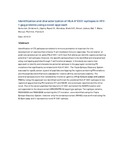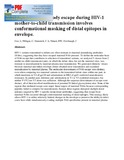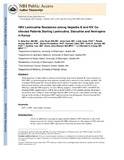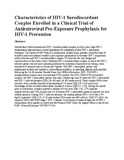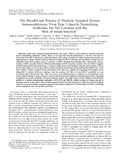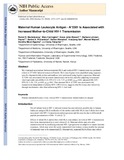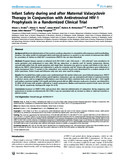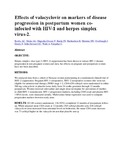Search
Now showing items 1-10 of 24
Identification and characterization of HLA-A*0301 epitopes in HIV-1 gag proteins using a novel approach
(2010-01)
Identification of CTL epitopes correlated to immune protection is important for the development of vaccines that enhance T-cell mediated immune responses. The correlation of positively selected amino acids (PS) of HIV-1 ...
Neutralizing antibody escape during HIV-1 mother-to-child transmission involves conformational masking of distal epitopes in envelope.
(2012-09)
HIV-1 variants transmitted to infants are often resistant to maternal neutralizing antibodies (NAbs), suggesting that they have escaped maternal NAb pressure. To define the molecular basis of NAb escape that contributes ...
Herpes Simplex Virus Type 2, Genital Ulcers and HIV-1 Disease Progression in Postpartum Women
(2011)
Background
Co-infection with herpes simplex virus type 2 (HSV-2) has been associated with increased HIV-1 RNA levels and immune activation, two predictors of HIV-1 progression. The impact of HSV-2 on clinical outcomes ...
HBV Lamivudine Resistance among Hepatitis B and HIV Co-infected Patients Starting Lamivudine, Stavudine and Nevirapine in Kenya
(2011)
Widespread use of lamivudine in antiretroviral therapy may lead to hepatitis B virus resistance in HIV-HBV co-infected patients from endemic settings where tenofovir is not readily available. We evaluated 389 Kenyan ...
Characteristics of HIV-1 Serodiscordant Couples Enrolled in a Clinical Trial of Antiretroviral Pre-Exposure Prophylaxis for HIV-1 Prevention
(2011)
Introduction
Stable heterosexual HIV-1 serodiscordant couples in Africa have high HIV-1 transmission rates and are a critical population for evaluation of new HIV-1 prevention strategies. The Partners PrEP Study is a ...
The Breadth and Potency of Passively Acquired Human Immunodeficiency Virus Type 1-Specific Neutralizing Antibodies Do Not Correlate with the Risk of Infant Infection[down-pointing small open triangle]
(2011)
Although a major goal of human immunodeficiency virus type 1 (HIV-1) vaccine efforts is to elicit broad and
potent neutralizing antibodies (NAbs), there are no data that directly demonstrate a role for such NAbs in
protection ...
Valacyclovir Suppressive Therapy Reduces Plasma and Breast Milk HIV-1 RNA Levels During Pregnancy and Postpartum: A Randomized Trial
(2012)
Background. The effect of herpes simplex virus type 2 (HSV-2) suppression on human immunodeficiency virus type 1 (HIV-1) RNA in the context of prevention of mother-to-child transmission (PMTCT) interventions is ...
Maternal Human Leukocyte Antigen - A*2301 Is Associated with Increased Mother-to-Child HIV-1 Transmission
(2010)
We examined associations between maternal HLA and vertical HIV-1 transmission in a perinatal cohort of 277 HIV-infected women in Nairobi. HLA class I genes were amplified using sequence-specific oligonucleotide probes and ...
Infant Safety during and after Maternal Valacyclovir Therapy in Conjunction with Antiretroviral HIV-1 Prophylaxis in a Randomized Clinical Trial
(2012)
Background
Maternal administration of the acyclovir prodrug valacyclovir is compatible with pregnancy and breastfeeding. However, the safety profile of prolonged infant and maternal exposure to acyclovir in the context ...
Effects of Valcyclovir on markers of disease Progression in Postpartum Women Co-Infected with HIV-1 andHerpes Simplex Virus-2
(2012-06)
Objective:
Herpes simplex virus type 2 (HSV-2) suppression has been shown to reduce HIV-1 disease progression in nonpregnant
women and men, but effects on pregnant and postpartum women have not been described.
Methods:
We ...

